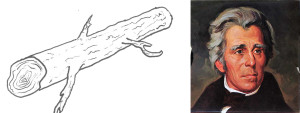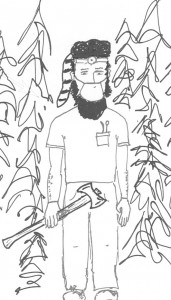By Coma News Intern and Historian, Stan Bargmeyer
First discovered by Vincent St. Preaux in 1832, Coma’s famous Log-that-Resembles-Andrew-Jackson was the toast of the town for nearly two decades. The eight-foot log captivated residents of Coma, who found the uncanny resemblance to War of 1812 hero, Andrew Jackson, to be a sign that the town was destined for greatness.

Above: Can you tell which of the above is the log and which is President Andrew Jackson? Neither could many Coma residents in the 1830s.
As St. Preaux recounted his discovery in a letter to Coma physician, Adolphus Pratt, in 1844;
“As I stumbled through the wild, my heart suddenly sank to some deep recess of my body. Who is this I have trespassed upon on this winter’s eve? It is the nation’s savior and president, Andrew Jackson! My heart raced as I drew near! I bowed in his presence and requested counsel with him but for only a moment. I asked him what great storm had altered his course in such a way that he now sat on the forest floor like a vacated elk carcass. It was only after many repeated unanswered questions that I took a closer look and realized it was not, in fact, our great leader, but a log.”
The log was put on display in a small park near the center of town. Visitors flocked from afar to see for themselves the miraculous log that some Coma residents claimed was an exact replica of the man who saved the nation from peril during a bloody war with the British.
Eventually, the fanfare surrounding the log subsided and many forgot about the precious artifact.
However, in 1881, the log was rediscovered during park renovations. Eventually, the log was abandoned in the forest outside town.


 Follow
Follow
 comments feed
comments feed











